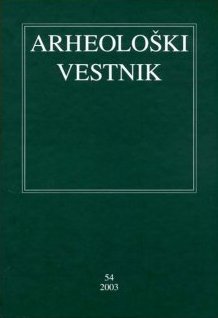A rare mythological scene at Gornji Grad: the tale of Scylla and Minos?
Keywords:
Roman period; aedicula tomb; Minos; Scylla; Menelaus; Helen; the Judgment of Paris; iconographic theme; Ciris epyllion; Noricum; Gornji Grad; SloveniaAbstract
The article discusses a central motif on the socle of a funerary monument at Gornji Grad, Slovenia. Together with those from Oswaldgraben (western Styria, province of Noricum) and Aquincum, it has been interpreted ever since the fundamental study written on the subject by Erna Diez as showing the reunion of Menelaus and Helen after the end of the Trojan War. This interpretation, how-ever, becomes less certain upon comparing the relief to a less well-known mirror from the Bulla Regia cemetery (province of Africa proconsularis). The latter shows an almost identical composition, but includes the figure of an elderly woman who does not appear in the reunion story. The main features of the scene, the hand on the hilt of the sword, the woman offering an object to the man, and the active role of Eros, can be found in another, rarely depicted myth, namely the meeting of Minos and Scylla, described in most detail in the Ciris epyllion. According to the latter, Scylla, the daughter of King Nisus, falls in love with the enemy King Minos after an intervention by Eros, and is aided, in conspiracy against her father and homeland, by her nurse.Iconographical analysis and literary sources have enabled the author to add four new depictions of Minos and Scylla to those already known. Three of those newly-added are depictions on stone reliefs, from Noricum (Gornji Grad, Oswaldgraben) and Pannonia (Aquincum), with the fourth one on the above-mentioned bronze mirror. All of them had previously been interpreted as the reunion of Menelaus and Helen after the end of the Trojan War.
Downloads
References
BAŽANT, J. 1992, Minos I. – In: LIMC VI 1, 570–574; VI 2, 311–315.
CANCIANI, F. 1994, Skylla II. – In: LIMC VII 1, 793; VII 2, 569.
CARTON, M. 1890, La nécropole de Bulla Regia. – Bul-letin archéologique du Comité des travaux historiques et scientifiques, 149–226, Paris.
CAZZANIGA, I. 1959, Intorno al verso 376 della Ciris. “amyclaeo spargens althariaa thallo”. – La parola del passato 14, 453–457.
DIEZ, E. 1952, Die Wiedersehensszene zwischen Helena und Menelaos auf provinzialrömischen Reliefs. – Ja-hreshefte ds Österreichischen Archäologischen Instituts. Beiblatt 39, 21–36.
DIEZ, E. 1953, Zur Wiedersehensszene zwischen Helena und Menelaos. Ein Nachtrag. – Jahreshefte des Öster-reichischen Archäologischen Instituts. Beiblatt 40,215–218.
DIEZ, E. 1966–1967, Nochmals Helena - Menelaos. – Ja-hreshefte des Österreichischen Archäologischen Instituts. Beiblatt 48, 92–108.
GHALI-KAHIL, L. 1955, Les enlèvements et le retour d’Hélène dans les textes et les documents figurés. – Paris.
HEBERT, B. 1993, Römerzeitliche Funde im Oswaldgra-ben in der Steiermark. –Fundberichte aus Österreich32, 139–153.
HEDREEN, G. 1996, Image, Text, and Story in the Recovery of Helen. – Classical Antiquity 15/1, 152–184.
HODSKE, J. 2007, Mythologische Bildthemen in den Häusern Pompejis. Die Bedeutung der zentralen Mythenbilder für die Bewohner Pompejis. – Stendaler Winckelmann-Forschungen 6, Ruhpolding.
KAHIL, L. 1988, Hélène. – In:LIMC IV 1, 498–563; IV 2, 291–358.
KAHIL, L. 1997, Menelaos. – In: LIMC VIII 1, 834–841; VIII 2, 562–565.
KASTELIC, J. 1998, Simbolika mitov na rimskih nagrobnih spomenikih. Šempeter v Savinjski dolini / Sepulchral Symbolism of the Mythological Imagery on Roman Tomb Monuments. Šempeter in the Valley of Savinja. – Ljubljana.
KLEMENC, J. 1955, Trojanska pravljica na nagrobnih spomenikih iz Šempetra ob Savinji. – Zbornik Filozofske fakultete 2, 57–70, Ljubljana.
KNOX, P. E. 1990, Scylla’s Nurse. – Mnemosyne 43/1–2, 158–159.
KOKOLE, S. 2003, Totius antiquitatis egregius admirator. Christophorus Raubar zwischen Kampanien und Krain. – In: J. Höfler, J. Träger (eds.), Bayern und Slowenien in der Früh- und Spätgotik. Beziehungen, Anregungen, Parallelen, 175–197, Regensburg.
KREMER, G. 2001, Antike Grabbauten in Noricum. Kata-log und Auswertung von Werkstücken als Beitrag zur Rekonstruktion und Typologie. – Österreichisches Archäologisches Institut. Sonderschriften 36, Wien.LIMC = Lexicon iconographicum mythologiae classicae.
LYNE, R. O. A. M. 1978, Ciris. A poem attributed to Ver-gil. – Cambridge classical texts and commentaries 20, Cambridge, New York.
PAHIČ, S. 1975, Gornji grad. – In: Arheološka najdišča Slovenije, 269, Ljubljana.
REINACH, S. 1890, Reliefs de miroirs en bronze. – In : Collections du musée Alaoui, 85–96, Paris.
ROBERT, C. 1914, Ein verkanntes Ciris-Bild. – Hermes49/1, 158–160.
SALIS, A. 1947, Antike und Renaissance. Über Nachleben und Weiterwirken der alten in der neueren Kunst. – Erlenbach, Zürich.
TOYNBEE, J. M. C. 1977, Greek myth in Roman stone. – Latomus 36, 343–412
VERCOUTRE, A. 1893, Le miroir de Bulla Regia. – Revue archéologique 22, 80–85.
WEEGE, F. 1913, Das goldene Haus des Nero. – Jahrbuch des Deutschen Archäologischen Instituts 28, 127–244.
WUILLEUMIER, P. and A. AUDIN 1952, Les médaillons d’applique gallo-romains de la vallée du Rhône. – Annales de l’Université de LyonTroisième série. Lettres 22, Paris.
ZAHLHAAS, G. 1975, Römische Reliefspiegel. – Kataloge der Prähistorischen Staatssammlung München 17, Kallmünz.
ZIEHEN, J. 1890, Römische, Bildwerke im Nationalmuseum zu Pest. – Archäologisch-epigraphische Mitteilungen aus Österreich-Ungarn 13, 43–72.
Downloads
Published
How to Cite
Issue
Section
License

This work is licensed under a Creative Commons Attribution-NonCommercial-ShareAlike 4.0 International License.
Authors guarantee that the work is their own original creation and does not infringe any statutory or common-law copyright or any proprietary right of any third party. In case of claims by third parties, authors commit their self to defend the interests of the publisher, and shall cover any potential costs.
More in: Submission chapter





